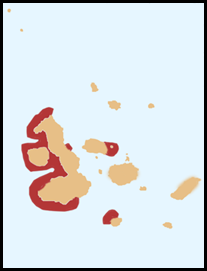Penguins

|
Galapagos Penguin
Splashing and swishing noises wake us each morning at six, our new little friends fishing for the tiny fish who use Beez hull for shelter. The Galapagos Penguin (Spheniscus mendiculus) is endemic to these Islands. They can survive due to the cool temperatures resulting from the Humboldt Current and the cool waters from great depths brought up by the Cromwell Current. These chaps are one of the banded penguins, other species live mostly on the coasts of Africa and mainland South America.
Description: The average Galapagos Penguin is nineteen inches long and five and a half pounds in weight. It is the third smallest species of penguin. They have a black head with a white border running from behind the eye, around the black ear-coverts and chin, to join on the throat. They have blackish-grey upperparts and whitish underparts, with two black bands across the breast, the lower band extending down the flanks to the thigh. Juveniles differ in having a wholly dark head, greyer on side and chin, and no breast-band. The female penguins are smaller than the males, but are otherwise quite similar.
Distribution: Ninety percent of the Galapagos Penguins live on the western coasts of Fernandina and Isabela, but in small numbers they also occur on Santiago, Bartholomew, northern Santa Cruz and Floreana. The northern tip of Isabela crosses the equator, meaning that Galápagos Penguins occasionally visit the northern hemisphere, the only penguins to do so.
Ecology and behavior: These penguins eat small schooling fish, mainly mullet, sardines and sometimes crustaceans. They only eat during the day and normally within a mile or so of their breeding site. The temperature of the islands stays between fifteen and twenty eight degrees Celsius. The penguins put off breeding in El Nino years as their food becomes less abundant, reducing the availability of shoaling fish, leading to low reproduction or starvation. The strong sun is the main problem, their primary means of cooling off is going for a dip, but they do spend a lot of time on land. They stretch out their flippers and hunch forward to atop the sun from shining on their feet, they can lose heat from their flippers due to the food blood flow there. They also pant, using evaporation to cool their throat and airways. Galapagos Penguins protect their eggs and chicks from the hot sun by hiding them in deep crevices in the rocks. This species is endangered, with an estimated population of less than a thousand breeding pairs. The population underwent an alarming decline of over seventy per cent in the 1980’s, but is slowly recovering. It is therefore the rarest penguin species (a status which is often falsely attributed to the Yellow-eyed Penguin).
A juvenile before it has banding markings.
Breeding: Breeding begins when the temperature of the sea surface falls to around twenty four degrees Centigrade when there is more food available. Most nests are seen between May and January. The nests are made within a hundred and sixty feet of the water on the shore, usually on Fernandina and Isabela Islands. Adults stay near the breeding area during the year with their mate that they have chosen for life. When the penguins are breeding, incubation takes thirty eight to forty days with both parents helping out. After thirty days of the chicks being born and both parents sharing responsibility of taking care of them, the chicks have feathers that are brown above and white below. The Galapagos Penguin mates for life. It lays one or two eggs in places such as caves and crevices, protected from direct sunlight, which can lead to the eggs overheating. One parent will always stay with the eggs or chicks while the other is absent for several days to feed. The parents usually rear up only one child. If there is not enough food available, the nest may be abandoned. Bermudian naturalist Louis L. Mowbray was the first to successfully breed the Galapagos Penguin in captivity.
Predators: Because of the Galapagos Penguin's smaller size, it has many predators. On land, crabs, snakes, owls and hawks take their toll, while in the water they are preyed upon by sharks, fur seals and sea lions. They face many hazards due to humans, as well as the unreliable food resources and volcanic activity. Illegal fishermen interrupt the penguins’ nesting trees, and they are often caught in fishing nets by mistake.
ALL IN ALL BUSY LITTLE CHAPS |
